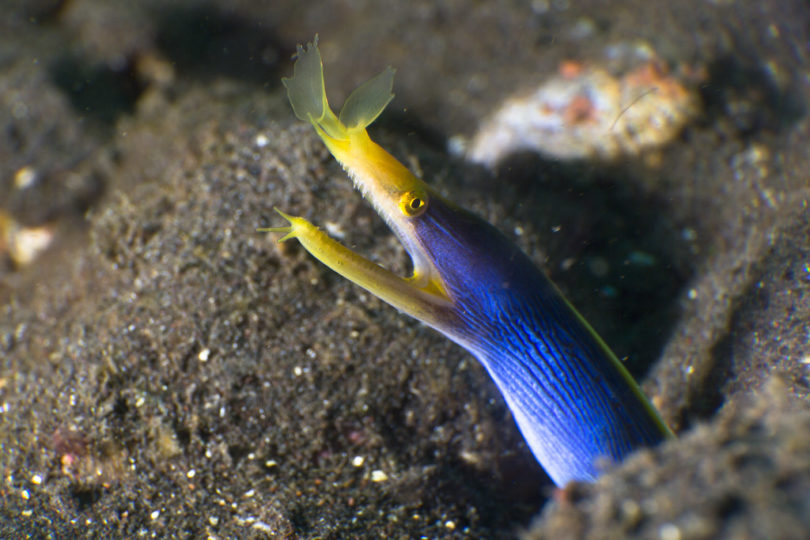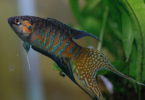Last Updated on November 19, 2022 by Matt
The Ribbon Eel, Rhinomuraena quaesita, is a species of moray eel which has a bright electric coloration, making it one of the most spectacular eel species around.
The Ribbon Eel is the only member of the genus Rhinomuraena. It is a member of the moray eel family Muraenidae, along with species such as the snowflake moray (Echidna nebulosa), the zebra moray (Gymnomuraena zebra), and the golden-tailed moray (Gymnothorax miliaris) which are commonly seen in the aquarium trade.
Muraenidae is a large family, with 200 species in 15 genera. The majority of species are exclusively marine, although there are a few freshwater and brackish species.
In this Ribbon Eel care guide, we will run through a description of the species and it’s distribution, its behavior and diet, reef compatibility, and tank mates.
IN THIS ARTICLE
Quick Ribbon Eel Care Sheet
| Ribbon Eel Summary | |
| Care Level | Expert |
| Family | Muraenidae |
| Temperament | Peaceful |
| Diet | Carnivorous |
| Origin | Indo-Pacific |
| Minimum Tank Size | 75 Gallons |
| Color | Black, Blue, Yellow |
| Size | 26-51 inches |
| Reef Compatible? | No |
| Temperature | 72-82°F |
| Carbonate Hardness | 8-12 dKH |
| Specific Gravity | 1.020-1.025 |
| pH Range | 8.1-8.4 |
Description and Distribution
The Ribbon Eel has a very long and thin body, with a high dorsal fin, giving a truly mesmeric appearance akin to a dragon. They have very distinctive flared and expanded anterior nostrils.
Uniquely amongst moray eels, it is a protandric hermaphrodite; similarly to clownfish they are born male and change sex when they grow and mature to female. They also have fascinating and drastic color changes as they mature from a juvenile, to an adult male, then to an adult female.
There are three color morphs, relating to their maturity and life stage.
Black Color Morph: As a juvenile they have a black coloration, with a bright yellow dorsal fin, immediately signalling the eel to be a Ribbon Eel.
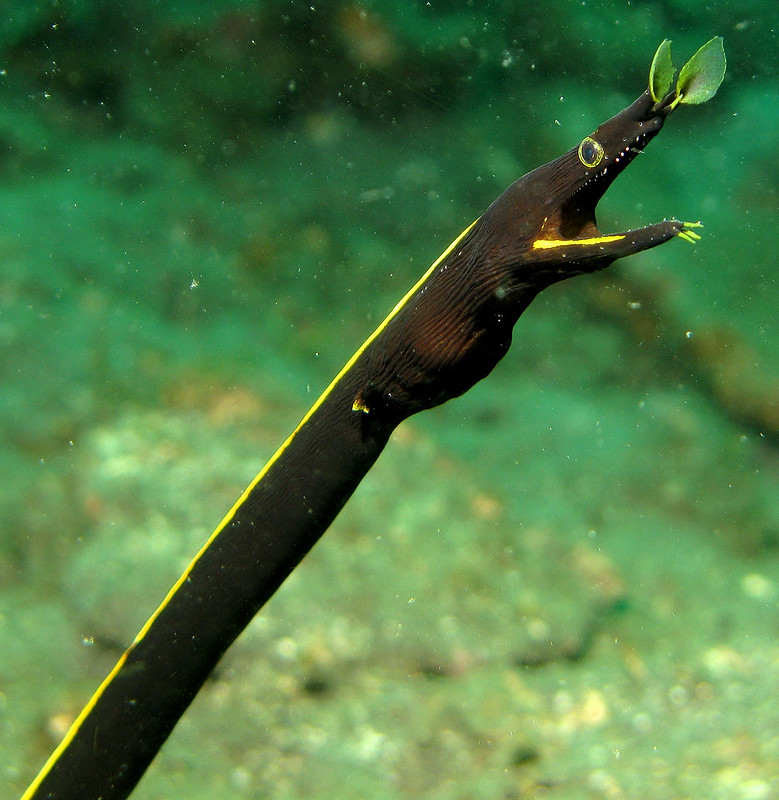
Credit: Steve Childs (Flickr)
Blue Color Morph: As the juvenile matures into an adult male it changes coloration drastically; it becomes an electric blue, still with the bright yellow dorsal fin. The inside of the mouth will become yellow as well. This electric blue and yellow coloration easily signals the male portion of the life cycle. It is a beautiful Ribbon Eel.
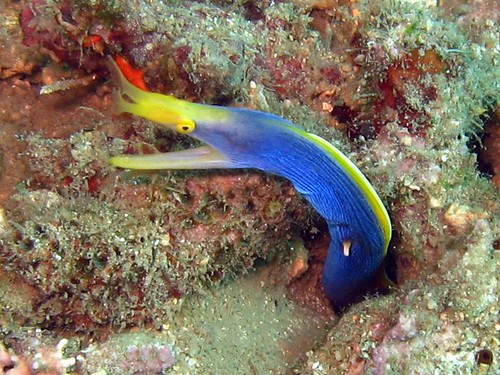
Credit: prilfish (Flickr)
Yellow Color Morph: As the fish again matures into an adult female another color shift is seen. This time the fish becomes a very bright yellow.
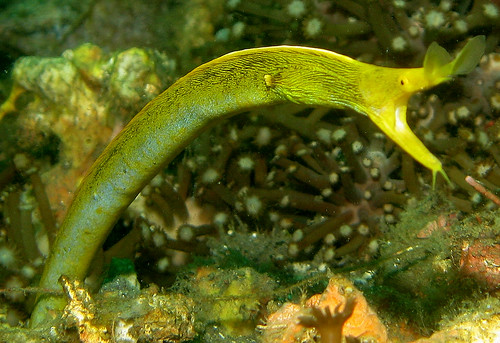
Credit: Steve Childs (Flickr)
At one stage these different color morphs were considered to be different species until it was found that they are just different life cycle stages of the same species.
However there is evidence to suggest that in captivity the color morphs don’t necessarily reflect the life stage. For instance both the Steinhart Aquarium and the Vivarium Karlsruhe have reported that adult Ribbon Eels displayed the black color morph. Vienna Zoo had an adult yellow female have eggs successfully fertilized by a black color morph eel, indicating it was indeed an adult male. Ribbon Eel are very difficult to successfully keep in an aquarium, so this evidence seems to indicate that there may be a lack of nutrients which prevents proper maturation.
Males are generally between 26 and 40 inches in length, while females are much larger at up to 51 inches in length.
In the wild, the lifespan of a Ribbon Eel can exceed 20 years. However it is substantially shorter in aquariums; they rarely live longer than a few years, and they have never actually been successfully bred in an aquarium. This difficulty in aquariums means they are only suited to expert aquarists.
Ribbon Eels are found throughout the Indo-Pacific region, from East Africa, throughout the Philippines and Indonesia, to the islands of the central Pacific such as French Polynesia. They are found in lagoons and seaward reefs, up to around 60 meters depth. Often seen by divers with their head protruding from nooks and crevices in the sand, rock, and rubble habitat. It is rare that they are seen swimming openly in the water column.
Behavior and Diet
As said previously, Ribbon Eels normally keep to their holes, having their heads sticking out from the rock. Due to this natural propensity to keep in place, it is rare they are seen out in open water. If you are lucky enough to see one swimming you will soon see why they have the name Ribbon Eel!
Juvenile Ribbon Eels are solitary, while males aren’t generally territorial and are often seen together. Two male Ribbon Eels often share the same hole. Due to their propensity to stay in one place, they can often stay in a single territory for many years.
Male and female Ribbon Eels don’t mingle, only encountering each other when it is time to mate. Once they have mated, the females lay fertilized leaf shaped eggs. It is almost impossible to get Ribbon Eels to mate in the aquarium; it has only ever been achieved a few times.
The eggs of eels hatch into flat and transparent larva called leptocephali. These larvae drift in the surface waters of the sea feeding on dissolved nutrients, before developing into a young eel called an elver, seeking out a reef habitat to grow and mature.
Like all moray eels, Rhinomuraena quaesita naturally opens and closes its mouth in order to help with breathing. Opening and closing its mouth in this way forces water over the gills, oxygenating the blood. Often this is misconstrued as aggression, but this isn’t the case!
They are great escape artists, and so need a tight fitting lid on the aquarium or they will find a way out.
In the natural environment, their diet consists of small fish which they catch as they swim past their hole.
Feeding Ribbon Eels in the Aquarium
A common issue with Ribbon Eels is getting them to eat initially in the tank. However there are some ways that you can help this issue along.
First, when purchasing your Ribbon Eel ask if they have had success in feeding it, or better yet ask to watch it feed for yourself. If they haven’t been able to get it feeding then you are instantly at a disadvantage, as it needs to be moved to your tank which will stress it greatly.
When the eel is in your home tank, getting them feeding is the most important thing. To initiate feeding you can try a few different things. Offer them live fish with a red or orange coloration such as Rosy Reds, Guppies, or small goldfish. While these are freshwater fish, and so aren’t the best diet for a marine animal, the idea is to get your Ribbon Eel eating as quickly as possible in your tank. These fish are the perfect size for Ribbon Eels to predate upon, and their coloration means the eel is more likely to see it.
Another way of getting your new eel to feed is to initiate a feeding frenzy. If there is more than one Ribbon Eel in the tank then when a prey item is introduced to the tank they basically rile each other up. As each individual Ribbon Eel gets more excited over the food the other gets more excited too, and it kicks off a feeding frenzy. If there is one individual in the tank then a feeding frenzy can still be started with the other fish, although the Ribbon Eel may not go for the food.
Another clever technique for getting your Ribbon Eel feeding is to trick it into thinking another eel is interested in the food. Using grabber tongs, such as the JBJ Grabber Tongs to wave and move the food in front and nearby the Ribbon Eel can entice it to feed.
Once your Ribbon Eel has started to feed in the tank then you can begin to wean it to more appropriate food, such as marine fish like silversides. While they will eat anything that fits in their mouths, such as invertebrates like crabs and shrimp, they need a fish-based diet.
A Ribbon Eel has very poor eyesight, and mainly uses its incredible sense of smell to detect food. Just look at those nostrils! As such once they have started feeding and you have got them used to the appropriate food they will perk up and might emerge when food enters the tank.
Compatibility and Tank Mates
They will eat anything that can fit into their mouths, and so aren’t suited to tanks with small fish and invertebrates. While invertebrates aren’t necessarily on the menu in the wild, in the aquarium they will be opportunistic. This means that they aren’t necessarily reef safe. With care though they can be completely reef safe. However they aren’t aggressive fish towards larger reef fish that they can’t eat!
While a Ribbon Eel shouldn’t be housed with other moray eel species, they can happily be housed together. Make sure to get males, as females and males may not get on. Otherwise, if a reef fish is large enough not to be eaten by the Ribbon Eel then it is a suitable tank mate.
Saying this, given the trouble with feeding Ribbon Eels, large aggressive fish like the larger wrasse species may eat the food intended for the Ribbon Eel before they have a chance to get it.
As a Ribbon Eel needs substrate and rock crevices and caves to hide in; they aren’t suitable for fish only tanks.
To give your Ribbon Eel the best chance of thriving in a fish tank environment they need certain requirements to be met. They require very clean water; no level of ammonia, nitrite, or nitrate is acceptable. Ammonia poisoning and nitrate poisoning is very serious. A protein skimmer is a must to remove dissolved organic compounds, as is a good aquarium filter to maintain water quality. Regularly cleaning the tank is a must as well, including water changes. Water changes can be made easier using a product like the Python water changer. Keeping the water clean and water quality high is much easier if you use RODI water.
A temperature range of 72-82°F needs to be maintained, though they prefer a range of 72-78°F. An aquarium heater and thermometer should be utilized to maintain this range. A pH of 8.1-8.4 is needed, and a carbonate hardness of 8-12 dKH, although in the Vienna aquarium the eels are kept in water with 3.2 dKH.
Special Requirements
It is incredibly difficult to keep Ribbon Eels in the aquarium successfully. They are often known to stop eating, or to refuse food. This can and will cause them to starve.
Making your Ribbon Eel as comfortable as possible is very important. They need places in which to hide, as they do in the natural environment. Therefore a lot of live rock is absolutely essential, and placed in a way that there are lots of crevices for the eel to explore. However Ribbon Eels are very inquisitive, and may disturb rockwork if they are just placed on top of each other. To prevent collapsing live rock and to ensure that the Ribbon Eel has a place to live, using PVC plastic tubing to create a man-made hole can be a great idea.
Ribbon Eels prefer a fine sandy substrate, and this works well to place tubing under the sand. Having multiple exit and entrance holes means they have a network of caves to explore. Use tubing with a 45° angle for the entrance holes, which will enable them to rest with their heads out as they do in nature. Some 45° angles under the sand make for a great network, or a H shaped network of tubing.
This tube network under the substrate alone with tubing in the rockwork will give the Ribbon Eel plenty of space to explore.
While tubing in the rockwork isn’t strictly necessary, it is easier than making holes in live rock and glueing together rock to create the caves.
Ethical Considerations
As difficult as it is to face, before you try your hand at keeping a Ribbon Eel you need to consider the ethics of keeping this fish in a tank.
The major ethical consideration is that these fish cannot be captive bred at this time; it was a major breakthrough when fertilized eggs were successfully hatched, but none of the resulting fry survived long.
As such all individual Ribbon Eel that you will see for sale have been captured from the wild. This has knock on effects on the population and biodiversity of the region in which they were captured. As a Ribbon Eel spends the vast majority of its time hiding in its hole waiting for passing prey items, they are difficult to capture. To remove these fish divers often use a cyanide mixture to flush them out. As you can imagine, this isn’t the healthiest for the Ribbon Eel, and this accompanied with the travelling involved in getting the Ribbon Eel to where it is needed means that the eel is very weak.
This may have big knock on effects. It may have an impact on the life span. In the natural environment they can live over 20 years; in a fish tank they often only live for a few months before dying.
They are also finicky eaters, and often it is very difficult to get them eating. This could be due to the stress involved in their capture and transport, but it could also be as they find the fish tank environment inherently stressful. This could also explain the reduced lifespan in captivity.
Conclusion
Hopefully this Ribbon Eel care guide has been informative and useful. Ribbon Eels have an incredibly interesting life history, being black as a juvenile, maturing into an electric blue male, then finally maturing into a yellow female ready to lay eggs.
It is notoriously difficult to successfully keep and care for a Ribbon Eel in an aquarium. They are finicky eaters and getting them feeding is very hard. They also require a specialist tank to be set up with them in mind; it is very hard to install PVC tubing under the sand and within live rock in an already scaped aquarium! As such only very advanced and experienced aquarists are advised to keep a Ribbon Eel.
It is also necessary to seriously consider the ethical issues with keeping a Ribbon Eel in the home aquarium.
However they are an incredibly beautiful fish which can truly be a centerpiece of any marine reef tank.
Featured Image Credit: prilfish (Flickr)

